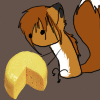
******************************Please Fave the Original Submission here.
We hope you're "Hungary" for this dish from
 !
!Open For Critique / Constructive Criticism******************************Heya people.
It's cooking bearkitty
 ghostbear2k writing again.
ghostbear2k writing again.And this time we will stay with the old classics: Pörkölt and Csipetke.
While most of the world would call this dish Goulash, the original Hungarian name is Pörkölt. A thick, carefully braised stew that is typically served with a kind of homemade, simple noodles called Csipetke.
What they call Goulash is actually a kind of "Goulash soup".
Not sure while the whole world mixed that up ^.^'
So here is what you need:
Ingredients for the Pörkölt:
1,5 g of beef, cut into not too small cubes or pieces (usually you can buy "goulash meat" from the butcher, but about any beef is fine. Does not have to be a prime cut. It's was a very simple meal for people, so typically it contains some fat and connective tissue. Don't worry, it will turn soft and juicy. Believe me :3)
1,5kg of onions ( I used red onions and white onions)
About 600ml of beef stock (vegetable stock is fine as well. It even works with water, although I would not recommend it)
Dry red wine
3-5 gloves of garlic
1-2 tablespoons of tomato paste
Fresh herbs (rosemary, sage, thyme, marjoram or oregano, bay leaf (use only 1), allspice seeds)
Paprika powder (2 heaping tablespoons of sweet plus one tablespoon of hot paprika powder. Adjust the hot paprika powder to your taste. I used 1, only slightly heaped tablespoon)
150g Lard or clarified butter
salt, freshly ground pepper, optional Garam marsala
(Optional: finely cut red bell pepper, just put it into the dish and let it cook with everything else)
Ingredients for the Csipetke:
300g wheat flour
1 egg
pinch of salt
125ml water
Preparation:
Do some little mis en place. Peel onions and chop them into pieces, wash the meat and dry it by tapping with kitchen paper. Peel the garlic cloves. Leave them intact for now and just before use just crush them with the flat side of your kitchen knife. Wash and dry the herbs.
You can pour all herbs and the garlic into paper tea bags. That way you can just cook them and take them out without much of a hassle after the dish is done.
Now heat up the lard or clarified butter in a large roasting pan, pout in the meat and sear it until the outside is brown and some residue will be left on the bottom of the roasting pan. This way the juices will stay inside. Take out the meat, cover it and put it aside for the moment. You can sear it in batches, so the fat with not cool down too much.
Pour in the onions and carefully sweat them until the are glassy and soft (that step will take about 20 minutes, don't use too much heat). Add the tomato paste and slowly roast it with the onions. You'll notice a build-up of dark brown residue on the bottom of the roasting pin. That is supposed to happen and the source of the taste :)
Now turn down the heat a bit before you add the paprika powder into the delicious mixture of fat, meat juice, tomato paste and onions and stir until it's mixed in.
Be very careful not to burn it! Burnt paprika powder tastes horrible and will just ruin your entire dish!
Now deglaze: Pour in about a glass of dry red wine and let it evaporate while stirring. Pour in another glass, let it evaporate. Rinse, repeat as often as you like. That way the alcohol evaporates, leaving just the taste. You'll note the brown residue starting to disappear as well.
If you're done with the red wine, put the meat back into the roasting pan and pour in stock until everything is covered. Add (the teabags with) the garlic and herbs.
Cover the pot and let it simmer on low heat for at least 3 hours. More time will not hurt. Make sure the meat is soft and juicy and the connective tissue has turned into gelatin due to the slow cooking
Check in about every hour, add some more stock if necessary.
After the time is up take out the meat, together with some of the onions and herbs. Now use a food mill, chinois or immersion blender on the remaining sauce and onions. This will add a very nice taste and will already thicken the gravy. Season to your taste. Let it cook a bit longer so more liquid can evaporate.
If you like you can take some corn starch, dissolve in cold water, pour it in, heat it up until it bubbles to thicken the sauce even more.
If the texture feels right for you, put in meat and onions and carefully warm them again.
During the last hour of cooking time you can prepare the Csipetke.
Just mix flour, egg and salt, knead into a dough until it doesn't stick anymore. Wrap it into some cling film and let it rest in the fridge for about 30 minutes.
Take it out again, roll it out to a thickness of about 0,5 - 1cm on a mealed surface. Then just take your fingers, pinch of a little of the dough and either press it slightly into a flat piece or roll it up into a tiny ball. That depends on you. It doesn't have to be exact.
Cook the Csipetke in salted water. If the start to rise to the surface they are almost done.
Serve your Pörkölt with the freshly cooked Csipetke and enjoy your meal!
******************************This recipe contains alcohol. Please use it and in your recipes responsibly.
Allergy warning – please read all recipes carefully and be aware of any allergies or sensitivities that may affect your health and well-being
Category Photography / Tutorials
Species Unspecified / Any
Size 1200 x 897px
File Size 552.9 kB
Recommendation from a professional chef... Work a on your presentation... If yer gonna be taking pictures of food and presenting them to people (which I'm not saying don't by any means, all power to you) but work on yer presentation so the food looks nice... EG: This would look MUCH better had the pasta bean tossed in the sauce and presented with out the pooling on left side of plate like that or alternatively you could have put the sauce in the middle (since it's a braised meat dish this would likely have been better) and ringed it with the pasta.
Also, remember that presentation isn't always just how it looks, sometimes the presentation choices have more to do with how the food interacts with it's components as a whole dish. Just a thought, take it or leave it, sounds nummers either way.
Also, remember that presentation isn't always just how it looks, sometimes the presentation choices have more to do with how the food interacts with it's components as a whole dish. Just a thought, take it or leave it, sounds nummers either way.

 FA+
FA+













Comments